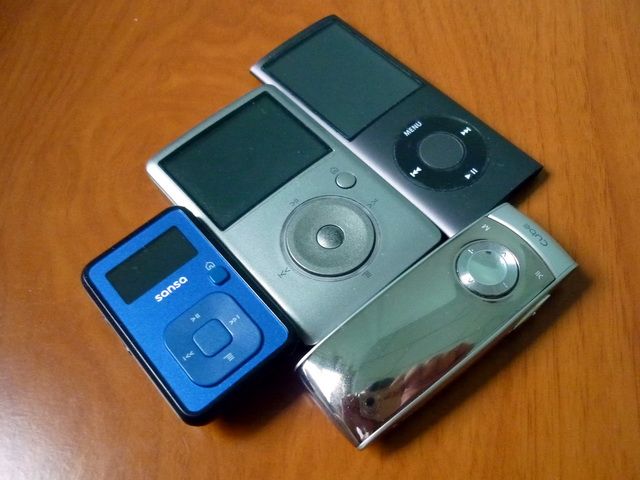
Clip+, Fuze, C30 and Nano 4G.
SPEC
Internal Storage: 2GB. 4GB. 8GB
Memory Expansion: Micro-SD slot
Port: Headphone-out, USB2.0.
Key: Home, Play/Pause, Next/Forward, Previous/Rewind, Menu, Select, Vol+, Vol-, Power.
Display: 1 inch two tones OLED
File Format Support: MP3, WMA, FLAC, WAV, OGG, Audible
EQ: Normal, Rock, Pop, Jazz, Classical, Funk, Hip Hop, Dance, Bass, Treble, User.
Weight: 24.5g
Battery Life: 15hrs.
FM Radio, Voice Recorder, Belt Clip.
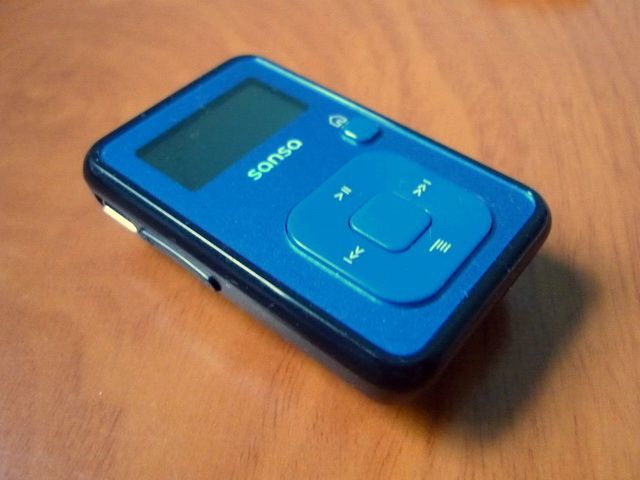
USB and Volume control on the side
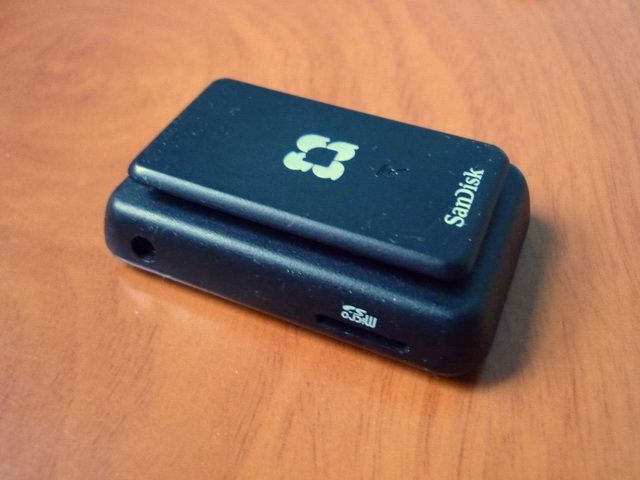
Headphone-out, microSD slot and the big clip.
Build Quality and Navigation
Clip+ is overall a very simple and solid player. It is small and light enough that it will ‘disappear’ a few minutes after you start using it, making it possibly the best work-out DAP you can ever have especially since the belt clip is already in place for you to utilize. But the strength is also its weakness, sort of. First, the clip itself can’t take a lot of stress or else it will break off. Second, the small and lightness of the player with the hard plastic finish means it is really easy for the player to slip out of hand when operating the button (or press the wrong button). Big fingers like mine and volume adjustment with one hand almost always result in the little player flying away like a rocket (*a silicone case from eBay can do wonder here). Third, the screen might be a bit too small for those who don’t see so well. Fourth, the placement of the headphone jack is odd. It is on the right side of the player and only works well with 90 degree plug. Long straight plug on Clip+ just looks awkward. Beyond these minor issues, my experience with the Clip+ build quality so far is very much positive.
Navigation is simple and straight forward. In fact it is almost identical to Sansa Fuze besides having a two tone OLED screen with no video support. Though the screen is small, the real issue is how Sandisk wasted a lot of screen space. Things like volume or even time can be displayed in the main music playback screen without affecting the display of song title yet Sandisk has chosen to put empty space everywhere then use font that is one side too small.
I haven’t done a battery test on my Clip+ but I can confirm that it will run at least 10+ hours, which is quite in line with the official spec of 15 hrs.
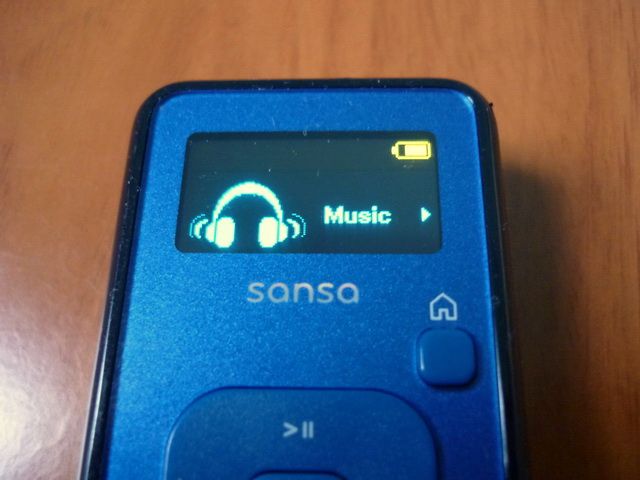
Original firmware UI
Sound Quality
I mainly compare Clip+ to the old trusty Fuze and my current choice of on-the-go DAP, the Cube C30 (a.k.a. Nationite N2) using HifiMan RE0. Amped via a decent LOD, Fuze is best sounding between the three (amp or not for the other two), but here I am only interested on their headphone-out purely on determining which offers the best sound for an ultra portable setup. If size and weight is not a concern, I am pretty sure my S:flo2 / HM602 / HM801 sound better to my ears, but they are not exactly ‘ultra portable’.
First, the difference between Fuze (v1 by the way) and Clip+ - overall it is very similar. If I have to make up a number I’ll say the similarity is 95% or so. What is the last 5%? The fullness. Clip+ sounds just a tad fuller than Fuze in every note, volume matched of course. It might not be a lot but it does make Clip+ sounds slightly warmer, livelier and more energetic compared to Fuze. On the same time, it also takes away a little of ‘air’ from Fuze’s soundstage. Overall the difference is too subtle to say whether it is an improvement or a flavoring. Purely on the headphone-out however, I think I do prefer Clip+ slightly fuller sound over Fuze, but it is more of a personal preference.
On my previous impression of the C30 (or actually the Gumstick review as well), I’ll say that I prefer C30 over Fuze because C30 sounds less compressed and more lively, especially on harder to drive IEM. The same conclusion pretty much applies to Clip+, but in a lesser degree. While Clip+ still sounds more compressed in comparison, it is not as dull as Fuze because the slight fullness in Clip+ is able compensate for the dullness found in Fuze. While C30 still has a better soundstage and resolution, the difference between C30 and Clip+ is certainly closer compared to that of Fuze. In a pitch, I really don’t think most will notice the difference. However, at least for now, my scale is tilting toward C30 because it has BBE, which is a much more functional and effective EQ system than mediocre preset EQ found on Clip+.
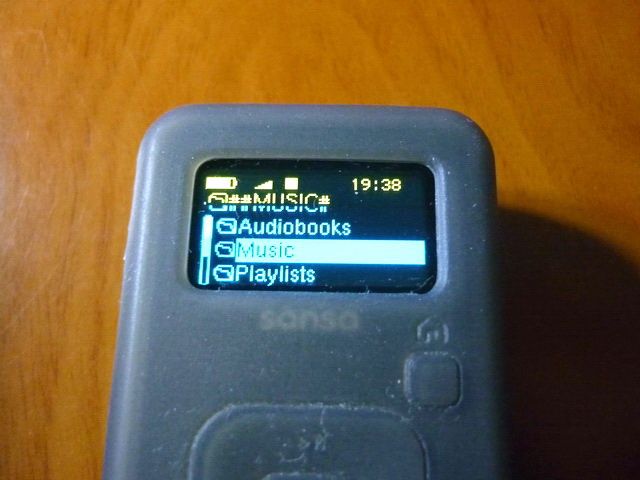
RockBox UI. Clip+ in silicone case.
RockBoxed
RockBox seems to be a ‘must’ when it comes to people’s recommendation to new Clip / Clip+ user. I installed it to both Fuze and Clip+ just to try it out. Overall the experience is richer on the Clip+ than it is on Fuze v1 (*which somehow sucks a lot of battery life out than the original firmware, making it a much less attractive alternative than it is on Clip+).
For the Clip+, you get a more useful and somewhat customizable UI, offering on screen information and setting that Sandisk should have included in the first place. It also gives you a more useable EQ system with great tune-ability. However if you are not particularly interested in EQ, there really isn’t thing that you will miss by not installing RockBox on Clip+. The sound quality is pretty much the same between the original firmware and RockBox, so the main difference is on the ‘play-ability’ / customization. Depends on what you need, RockBox can be useful or just a fancier interface. I mainly stick to the original firmware because I have Audible audiobook loaded on Clip+ and it doesn’t work on RockBox. While the EQ is great compared to the Sandisk preset, I am much less interested in playing with all the dials, which are too many for my own fancy.
Verdict
Overall the Clip+ is a fun and good sounding DAP to have, especially since the price has been driven down lately. Unfortunately this only applies more or less only to the U.S. market as Sandisk seems to ignore most, if all of the rest of the world as if people ‘out there’ are only interested in memory card but not DAP. By parallel importing the Clip+ however, the benefit of low price becomes slimmer after the price jack and shipping cost. It compares well to C30 both on value and function but at the end it is not going to replace it any time soon, at least not in my house. For those who just want a simple DAP with decent sound quality for workout or as an ultra portable travel / commuting rig however, Clip+ is still a very good choice.





